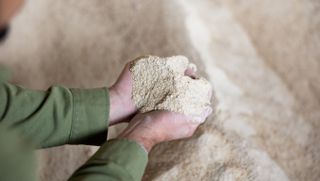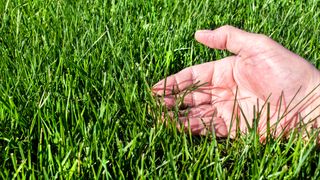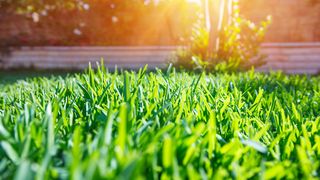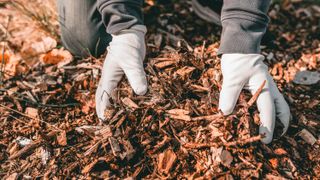What is corn gluten meal and how can it benefit my yard?
Can this natural herbicide help your yard?

When thinking of ways to grow lush green lawn, there’s no shortage of ideas, but have you ever thought of corn gluten meal? Turns out that it’s a natural herbicide. “Corn gluten meal is a natural byproduct of the corn milling process and is commonly used in animal feed due to its high protein content, explains Gene Caballero, co-founder of GreenPal in Nashville, TN. However, he says it also has significant benefits to your yard.
According to Iowa State University’s Department of Horticulture, Nick Christians, one of Iowa State University’s horticulture professors, was actually using corn gluten meal as he studied turfgrass diseases when he noticed that it negatively impacted grass seed germination. In 1991, he was granted a patent to use corn gluten meal as a herbicide, and the patent was re-issued in 1993. It’s been widely used ever since.
Here’s how it can benefit your yard.
Pre-emergent herbicide

Caballero says the most notable benefit of corn gluten meal is its use as a pre-emergent herbicide. “It inhibits root formation in sprouting seeds, making it effective in preventing weed growth.” He recommends applying it early in the spring or fall before weed seeds germinate. “Keep in mind that it won't affect established plants or weeds, but can prevent new weeds from taking hold.”
Corn gluten meal can be used on crabgrass, dandelion, pigweed, purslane, and various other types of germinating seeds.
It’s available in a granulated form and a powdered form. Both are effective, but the former may be easier – and less messy – to apply in your yard.
There are also a few tips that can determine the effectiveness of your application.
Sign up to get the BEST of Tom’s Guide direct to your inbox.
Upgrade your life with a daily dose of the biggest tech news, lifestyle hacks and our curated analysis. Be the first to know about cutting-edge gadgets and the hottest deals.
For example, Caballero recommends applying it during dry weather. “Wet conditions can reduce its effectiveness as a weed inhibitor.”
However, you should indeed water your lawn lightly after application to activate the corn gluten meal, then allow the lawn to dry, he says. This process will kill those weeds that have already germinated, and stop them from forming a root.
In addition, Caballero says timing is crucial for weed control. “Apply it just before the weed's growth period.”
Regarding ratios, Iowa State recommends evenly spreading 20 pounds per 1,000 square feet.
Natural fertilizer

In addition to being a natural herbicide, Caballero says corn gluten meal is beneficial to your yard in another way. “Corn gluten meal contains about 10% nitrogen by weight, making it a fantastic slow-release, organic fertilizer,” he says.
By nourishing your grass over time, he says it will promote a lush, green lawn.
Safe for pets, children, and the environment

The Environmental Protection Agency notes that herbicides can be hazardous to the environment. It can enter the surface water, contaminate storm waters, and float downstream.
In addition, it can kill fish and invertebrates. In addition, it causes plant decomposition and trophic structure.
“Unlike many chemical herbicides and fertilizers, corn gluten meal is non-toxic and safe for use around children and pets,” Caballero says.
Keep in mind

If you’re looking for quick results, this may not be the best product for your needs. A natural source has its pros and cons. “Results with corn gluten meal may not be immediate - like with synthetic products,” Caballero warns. For example, at the end of the first year, you may have only reduced the weed population by 60% at the most.
However, if you’re patient and use it correctly, he says it can be a vital part of a healthy, organic lawn care routine. By the second or third year, you should see promising results.
Also, while it’s referred to as corn gluten meal, there’s no actual gluten in it. And this is not the same fine and medium cornmeal used for pancakes, cornbread, and corn muffins. Nor is it the coarse cornmeal used to bread fish.
Alternatives

Another alternative is the use of herbicidal soaps. Admittedly, they’re not natural products, but are alternative to “regular” herbicides. Herbicidal soaps can be used on weeds, algae, and moss. And they can be applied on trees, driveways, fences, sidewalks and gravel. They’re a year-round product that can be used during any season. But keep in mind that herbicidal soap works best with young weeds.
Laying down organic mulch can also prevent the formation of weeds, and the mulch can be made of leaves, grass clippings, bark, and wood chips – among other materials. Mulch stops weeds from receiving the sunlight that they need. The mulch needs to be 2 to 3 inches thick to actually make a difference – but if it’s thicker than that, it may also block your plants from receiving nutrients as well. Another benefit of using organic mulch is that it can improve your soil when it breaks down, and since it keeps the soil moist, it’s easier to remove the weeds that you do find. However, depending on the size of your lawn, it may be hard to transport the mulch and time consuming to lay it down.
Weed mats (made of plastic) can also stop weeds from receiving sunlight, and suppress their growth. They come in various sizes, some with smooth textures, and the polypropylene material lets air and water pass through. They’re also easy to maintain, since the mats are durable enough to withstand rain and sun, and are also easy to remove when needed. Just make sure to get the right size so it will cover the weeds.
You can also just yank weeds out by hand, but it’s a time-consuming process. If you take this route, make sure you’re wearing protective gear, such as gardening gloves. Weeds respond better when they’re moist and soil is looser, so consider watering the garden or waiting until right after a good rainstorm. Also, you can also get some help to yank them out. A hoe or garden fork can make the process much easier. Just make sure that you don’t leave anything behind.

A mixture of dish soap, salt, and distilled vinegar is a powerful weed killer – but it may possibly kill your surrounding plants as well, so be sure to spray it intentionally. You’ll need a spray bottle, a gallon of vinegar, a cup of table salt, and a tablespoon of dish soap. This homemade weed killer may need to be applied several times on a weekly basis, until you see that the weeds are dying.
There are many ways to remove weeds. Corn gluten meal is one way to remove them without using poisonous substances. In addition, corn gluten meal can also serve as a natural fertilizer. And it’s safe to use around pets and children. However, keep in mind that it may take a while for this process to work, so you’ll need to be patient as you wait for the results.
Another alternative includes herbicidal soap, which can be sprayed anywhere. Organic mulch is another option, and it comes in a variety of materials including leaves, grass clippings, bark, and wood chips.
A weed mat, which is made of plastic, is easy to install and remove, and can also withstand rain and sun.
Good old-fashioned yanking out weeds by hand also works, just make sure the soil is moist so the process is easier.
Distilled vinegar, dish soap, salt can also be another option. Just be sure to apply it every week until you see results.
Depending on your needs – which include your environment, time constraints, and other factors, you’ll have to choose the best method for your lawn.
More from Tom's Guide
Terri is a freelance writer living in Birmingham, AL. She is an experienced mattress and bedding product reviewer, and has tested hundreds of home and tech products, with bylines at Architectural Digest, Popular Science, CNN Underscored, NBC News, The Daily Beast, USA Today, Homes & Gardens, Bob Vila, and Tom's Guide.

